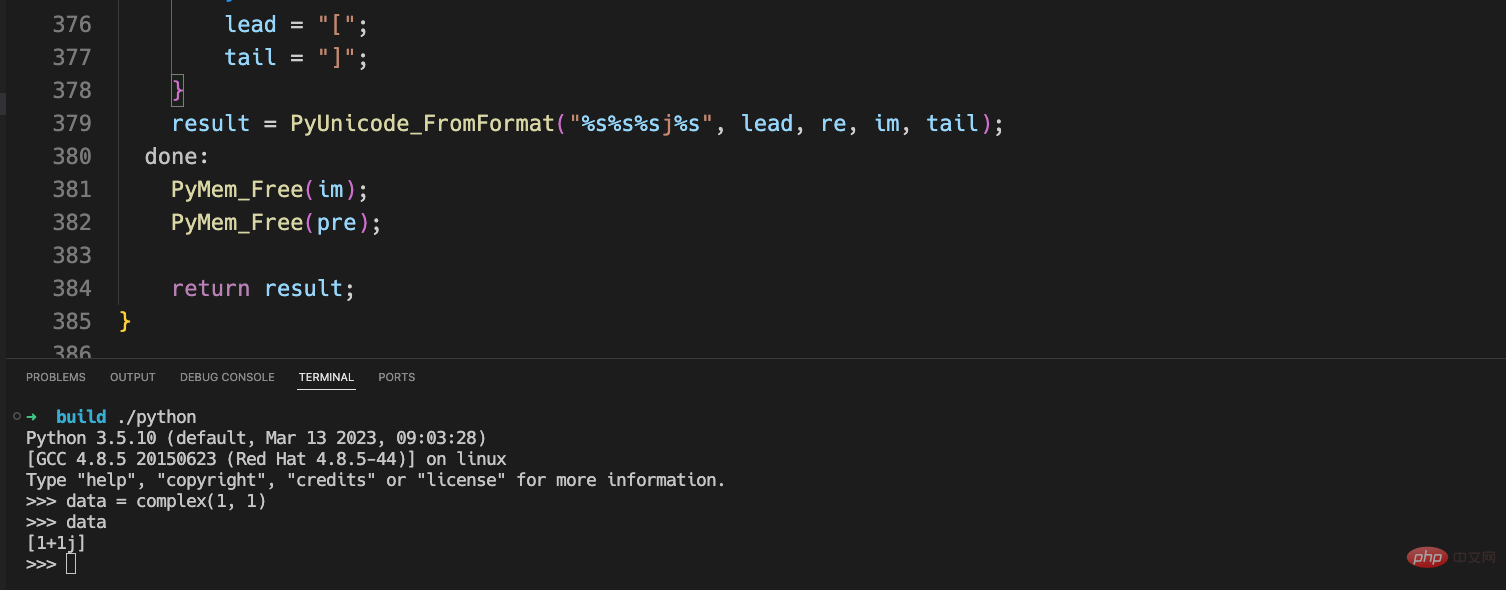ホームページ >バックエンド開発 >Python チュートリアル >Python 仮想マシンにおける複素数の実装原理は何ですか?
Python 仮想マシンにおける複素数の実装原理は何ですか?
- 王林転載
- 2023-05-13 10:40:211517ブラウズ
複雑なデータ構造
cpython での複雑なデータ構造の実装は次のとおりです。
typedef struct {
double real;
double imag;
} Py_complex;
#define PyObject_HEAD PyObject ob_base;
typedef struct {
PyObject_HEAD
Py_complex cval;
} PyComplexObject;
typedef struct _object {
_PyObject_HEAD_EXTRA
Py_ssize_t ob_refcnt;
struct _typeobject *ob_type;
} PyObject;上記のデータ構造図は次のとおりです。

cpython 仮想マシン全体では、複雑なデータは比較的単純である必要があり、PyObject ヘッダーに加えて、実部と虚部があります。
ob_refcnt は、オブジェクトの参照カウントの数を表します。これは、ガベージ コレクションに非常に役立ちます。後で、仮想マシンのガベージ コレクション部分を詳しく分析します。
ob_type, は、このオブジェクトのデータ型を示します。Python では、データのデータ型を判断する必要がある場合があります。たとえば、isinstance と type の 2 つのキーワードは次のようになります。中古フィールドです。
- #real は、複素数の実部を表します。
- imag は、複素数の虚数部を表します。
static PyObject *
complex_add(PyObject *v, PyObject *w)
{
Py_complex result;
Py_complex a, b;
TO_COMPLEX(v, a); // TO_COMPLEX 这个宏的作用就是将一个 PyComplexObject 中的 Py_complex 对象存储到 a 当中
TO_COMPLEX(w, b);
result = _Py_c_sum(a, b); // 这个函数的具体实现在下方
return PyComplex_FromCComplex(result); // 这个函数的具体实现在下方
}
// 真正实现复数加法的函数
Py_complex
_Py_c_sum(Py_complex a, Py_complex b)
{
Py_complex r;
r.real = a.real + b.real;
r.imag = a.imag + b.imag;
return r;
}
PyObject *
PyComplex_FromCComplex(Py_complex cval)
{
PyComplexObject *op;
/* Inline PyObject_New */
// 申请内存空间
op = (PyComplexObject *) PyObject_MALLOC(sizeof(PyComplexObject));
if (op == NULL)
return PyErr_NoMemory();
// 将这个对象的引用计数设置成 1
(void)PyObject_INIT(op, &PyComplex_Type);
// 将复数结构体保存下来
op->cval = cval;
return (PyObject *) op;
}上記のコードの全体的なプロセスは比較的単純です:
- まず、PyComplexObject から実数部を抽出します。 #抽出した 2 つの複素数を加算します。
- 取得した結果に基づいて PyComplexObject オブジェクトを作成し、このオブジェクトを返します。
- 複素数逆変換
複素数逆変換は実数部と虚数部を反転するだけで、これも比較的簡単です。
static PyObject *
complex_neg(PyComplexObject *v)
{
Py_complex neg;
neg.real = -v->cval.real;
neg.imag = -v->cval.imag;
return PyComplex_FromCComplex(neg);
}
PyObject *
PyComplex_FromCComplex(Py_complex cval)
{
PyComplexObject *op;
/* Inline PyObject_New */
op = (PyComplexObject *) PyObject_MALLOC(sizeof(PyComplexObject));
if (op == NULL)
return PyErr_NoMemory();
(void)PyObject_INIT(op, &PyComplex_Type);
op->cval = cval;
return (PyObject *) op;
}Repr 関数
ここで、複合型の repr 関数という興味深いメソッドを紹介します。この関数は、クラスの __repr__ 関数と同じ効果があります。複素数の出力を見てください。これは何ですか:
>>> data = complex(0, 1) >>> data 1j >>> data = complex(1, 1) >>> data (1+1j) >>> print(data) (1+1j)
複数形の表現に対応する C 関数は次のとおりです:
static PyObject *
complex_repr(PyComplexObject *v)
{
int precision = 0;
char format_code = 'r';
PyObject *result = NULL;
/* If these are non-NULL, they'll need to be freed. */
char *pre = NULL;
char *im = NULL;
/* These do not need to be freed. re is either an alias
for pre or a pointer to a constant. lead and tail
are pointers to constants. */
char *re = NULL;
char *lead = "";
char *tail = "";
// 对应实部等于 0 虚部大于 0 的情况
if (v->cval.real == 0. && copysign(1.0, v->cval.real)==1.0) {
/* Real part is +0: just output the imaginary part and do not
include parens. */
re = "";
im = PyOS_double_to_string(v->cval.imag, format_code,
precision, 0, NULL);
if (!im) {
PyErr_NoMemory();
goto done;
}
} else {
/* Format imaginary part with sign, real part without. Include
parens in the result. */
// 将实部浮点数变成字符串
pre = PyOS_double_to_string(v->cval.real, format_code,
precision, 0, NULL);
if (!pre) {
PyErr_NoMemory();
goto done;
}
re = pre;
// 将虚部浮点数变成字符串
im = PyOS_double_to_string(v->cval.imag, format_code,
precision, Py_DTSF_SIGN, NULL);
if (!im) {
PyErr_NoMemory();
goto done;
}
// 用什么括号包围起来
lead = "(";
tail = ")";
}
result = PyUnicode_FromFormat("%s%s%sj%s", lead, re, im, tail);
done:
PyMem_Free(im);
PyMem_Free(pre);
return result;
}ソース プログラムを変更して、次の 2 つの括弧を変更します。上記の () を [] に変更し、コンパイル後に実行します。 結果は次のようになります。
 #括弧が [] に変わっていることがわかります。
#括弧が [] に変わっていることがわかります。
以上がPython 仮想マシンにおける複素数の実装原理は何ですか?の詳細内容です。詳細については、PHP 中国語 Web サイトの他の関連記事を参照してください。
声明:
この記事はyisu.comで複製されています。侵害がある場合は、admin@php.cn までご連絡ください。

